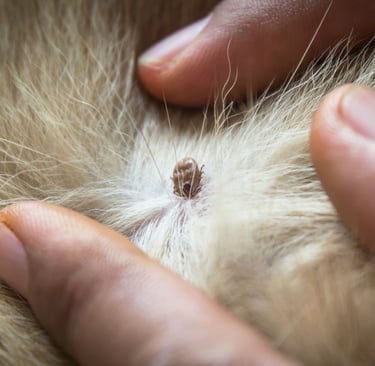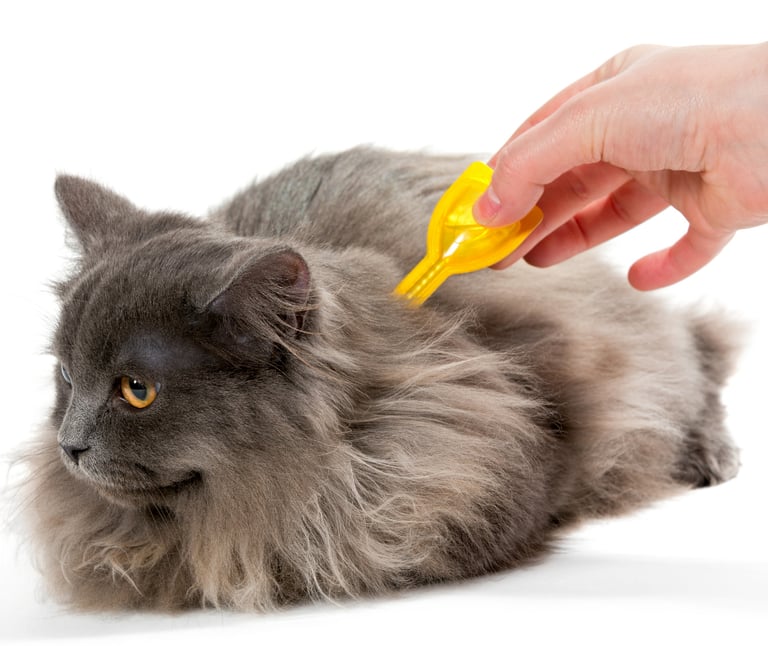How to protect your pet from fleas and ticks year-round
Learn how to prevent fleas and ticks in dogs and cats with simple, effective, and safe care tips to keep your pet healthy all year long.
8/11/20253 min read


Fleas and ticks are more than just an itchy nuisance — they pose real health risks to both pets and humans. Beyond causing intense itching and discomfort, these parasites can transmit serious diseases that may become life-threatening if untreated.
The good news is that with proper prevention and consistent care, you can keep your dog or cat protected all year long. In this guide, you’ll learn how to prevent infestations, choose the right products, recognize warning signs, and avoid common mistakes that compromise your pet’s safety.
Why flea and tick prevention matters
Fleas and ticks feed on your pet’s blood and can transmit dangerous diseases.
The main risks include:
Allergic dermatitis caused by flea saliva.
Lyme disease transmitted by ticks.
Ehrlichiosis and babesiosis, which affect the blood and can be fatal.
Anemia from severe infestations.
Tapeworm infection (Dipylidium caninum) transmitted by fleas.
Important: Even indoor pets can get infected — fleas and ticks can hitchhike into your home on clothes, shoes, or other animals.
Signs your pet may have fleas or ticks
Early detection increases the chances of effective treatment. Watch for these signs:
Persistent scratching or biting.
Bald patches or skin wounds.
Tiny black specks on fur (flea droppings).
Visible ticks — often found around ears, neck, armpits, or between toes.
Red, irritated, or inflamed skin.
How to prevent fleas and ticks
Prevention should be ongoing — not just when parasites appear. Here are the key strategies:
1. Regular use of preventive treatments
Flea and tick collars: provide long-lasting protection (up to 8 months depending on the brand).
Spot-on treatments (pipettes): applied directly to the skin, usually monthly.
Chewable tablets: protect from the inside out, with varying durations.
Always follow your veterinarian’s dosage and product recommendations.
2. Keep the environment clean
Vacuum carpets, sofas, and corners of the house frequently.
Wash your pet’s bedding and blankets weekly.
Use environment-safe flea and tick sprays or powders as needed.
3. Regular baths and brushing
Bathe your pet with anti-parasitic shampoos as recommended.
Brush their coat frequently to check for signs of parasites and remove loose hair.
4. Frequent Inspection
After walks or outdoor play, check your pet’s skin carefully, especially if they’ve been in grassy areas.
Pay close attention to hidden areas like ears, paws, armpits, and tail base.
Common myths about fleas and ticks
“My pet stays indoors, so it doesn’t need protection.” – False!
“Bathing alone solves the problem.” – False! You must combine hygiene with preventive products.
“There are no infestations in winter.” – False! Fleas and ticks can survive indoors year-round.
Mistakes that compromise prevention
Using human products on pets — they can be toxic.
Applying the wrong dose or forgetting reapplications.
Treating only one pet instead of all animals in the household.
Ignoring environmental cleaning.
When to see the veterinarian
If your pet shows severe itching, wounds, hair loss, or weakness, schedule a veterinary visit.
In advanced cases, medication may be needed to treat the infestation and any secondary infections or transmitted diseases.
Benefits of staying up to date on prevention
Protects against potentially fatal diseases.
Ensures comfort and quality of life for your pet.
Prevents infestations from spreading to your home and family.
Reduces long-term treatment costs.
Prevention ts tasier than treatment
Flea and tick control should be part of your pet’s regular care routine. With the right preventive products, a clean environment, and frequent inspections, you’ll keep your furry friend healthy, comfortable, and parasite-free.
Start today: talk to your vet, choose the best prevention method, and commit to year-round protection.
Want more pet care tips? Keep following our blog for essential guidance on keeping your dog or cat happy, healthy, and safe.




Health
Tips for a healthy and balanced life.
© 2025. All rights reserved.
Well-being
Privacy Policy
Terms and conditions
